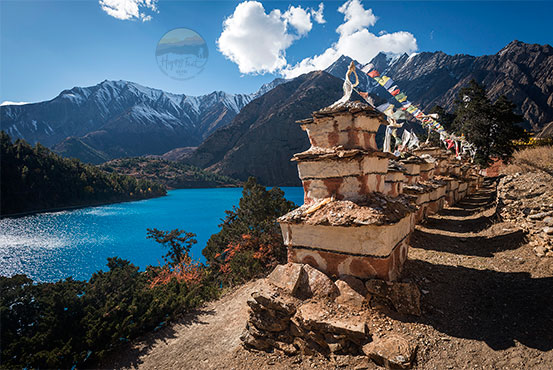-
Sunday - Friday: 9 AM - 4 PM
Dolpo Trekking, around the Far Wild West Himalayas of Nepal, is one of the least trekked areas of Nepal because of its difficult access, harsh terrain, physical challenge and high royalty; everything costs more to travel here. But those who travel here find purely Tibetan-influenced culture, tradition, and lifestyle simply unique, raising the question of what the whole country of Dolpo must have been like in the time of its full life and glory. One commentator has mentioned that Doplo is the last enclave of pure Tibetan culture left on Earth. So naturally, such things attract travellers here, and there are numerous books and movies on Dolpo, forcing people to go there, such as the metaphysical discussion in Peter Matthiessen’s book, The Snow Leopard.
Upper Dolpo Trekking generally takes you to the far-end corner of the vast Dolpo area within Nepal. The largest National Park of Shey Phoksundo, with an area of 3,555 sq, km lies in Dolpo, which has a lovely forest with blue pine, spruce, poplar, deodar, fir and birch tree lines to dwarf juniper and caragana shrubs around higher altitudes. Dolpo is also the home of the elusive Snow Leopard, blue ship and many other wild mountain animals. Blue ships and other mountain wildlife are usually spotted grazing on walks, which is almost rare around other Himalayan regions due to the high flow of trekkers.
Pure Tibetan Influence: The Upper Dolpo region shares a close cultural and historical connection with Tibet, as it lies near the Tibetan borderline. The Dolpopa people are the ancient-stream ethnic group in this region. They practice Mahayana Tibetan Buddhism and maintain all ancient aspects of Tibetan culture, including language, art, culture, and religious practices.
Geographical Isolation: Upper Dolpo has remained relatively isolated from mainstream Nepali society due to its remote location and challenging geography. Such natural isolation has allowed traditional customs, lifestyles, beliefs and practices to persist without external influence or modernization.
Buddhist Monasteries: The Upper Dolpo region is home to numerous ancient monasteries, such as Shey Gompa and Dho Tarap Monasteries. These spiritual centres serve as schools, courts for justice, and places of worship and play crucial roles in preserving Buddhist teachings, rituals, and social harmony, a unique property of the area.
Traditional Livelihoods: The local economy is based on animal husbandry (mainly yaks and sheep), traditional farming, and trade with neighbouring Tibet, which also extends to India during winter months. Ancient farming methods have been passed down for generations, unaffected by modernization. To this day, many Dolpopas knit and weave their traditional costumes at their homes using manually spun thread of sheep and yak wool and ancient looms.
Festivals and Rituals: The Saga Dawa festival is one of the most important annual celebrations that reflects the deep-rooted spirituality of the Dolpopa community. Such and other calendar events often feature colourful processions, religious mask dances, traditional music, folk dance performances, and rituals, highlighting their long-rooted rich cultural heritage.
Artistic Expression: Upper Dolpo showcases distinctive artistic expressions in thangka paintings, wood carvings, and handicrafts deeply intertwined with Buddhist themes and local traditions.
